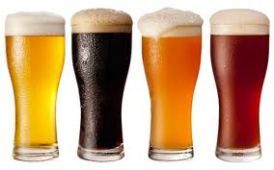Let’s talk about everyone’s favorite beverage: beer. (Just in time for your favorite irish holiday). The good new is, research has shown that alcohol is actually pretty healthy in moderation. It contains antioxidants that protect your cells and can help raise your HDL cholesterol (the good cholesterol). What do I mean by moderation? Two drinks per day for men and one drink per day for women. I’m not saying you can’t have more than that on a saturday night, I’m just saying you can no longer high five yourself for being healthy while sipping on your third drink.
Nowadays, when you walk into a bar or stroll down the beer isle in the supermarket (unless you live in one of those absurd states that doesn’t sell beer in grocery stores), you will find many different brands and types of beers. If you want to know how they differ in taste, you should probably just sample them all yourself. In terms of their calories and nutrition, here’s some info for you:
American Lager: These are the lightest in color and most heavily carbonated. Their recipes veer toward rice and corn as opposed to barely and hops. These ingredients add little flavor but help keep costs low. Examples: Budweiser, Michelob, Coors, Miller Genuine Draft, Pabst Blue Ribbon, Corona Extra, Foster’s Lager, Labett Blue, Yuengling. Caloric Range: 135-155
Light Lager: In an attempt to cut calories, these beers have less alcohol (2.5-4.2% compared to 5%) and fewer carbohydrates than American lagers. They are considered the least flavorful of all beers, but the best way to get drunk and keep your figure ;). Examples: Coors Light, Bud Light, Budweiser Select, Miller Lite, Michelob Ultra, Sam Adams Light, Amstel Light, Beck’s Premier Light. Caloric Range: 55-125
Pilsner: These beers are pale, light, and crisp. They tend to be tan and gold in color, but have slightly heavier bodies and less carbonation than lagers. Their recipes rely on four primary ingredients: barley, hops, water, and yeast. Examples: Victory Prima Pils, Pilsner Urquell, Czechvar, Bitburger, Lakefront Klisch Pilsner, Lagunitas Pils. Caloric Range: 120-170
Wheat Beer: These beers are created by thinning out the barley with significant doses of wheat during the fermentation process.Wheat carries a heavier load of protein, which creates a thicker head and cloudier look. Examples: Blue Moon, Shock Top, Hefeweizen, Sam Adams Cherry Wheat, Leinenkugel’s Sunset Wheat. Caloric Range: 150-170
Pale Ale: These are crisp and carbonated, but with the bitterness of a pilsner. Examples: Sierra Nevada Pale Ale, Bass Pale Ale, Anchor Liberty Ale, Young’s Bitter. Caloric Range: 140-180
IPA: Stands for India Pale Ale, these are ales with a little more “oomph”. They bring in loads of hops to cut through the sweetness of the barley, which leaves a lingering bitter taste on the tongue. Imperial IPAs are hop heavy and the strongest in terms of bitterness and alcohol. This also makes them high in calories, but they also contain more polyphenol antioxidants, which can lower your cholesterol and decrease your risk of cancer. Examples: Dogfish Head 60 Minute IPA, Stone IPA, Redhook Long Hammer IPA, Sierra Nevada Torpedo Extra IPA, New Belgium Ranger IPA. Caloric Range: 180-240
Porter: Defined by strong barley flavors with mild hops. They are generally black in color but aren’t quite as dark as stouts. They can taste like toffee and roasted nuts or sweet licorice and toast due to the roasting of the barley.Thy are medium- to full-bodied beers that go down thick and smooth like chocolate milk. Examples: Fuller’s London Porter, Anchor Porter, Yuengling Porter, Michelob Porter, Samuel Adams Honey Porter, Black Butte Porter, Flying Dog Porter. Caloric Range: 140-220
Stout: This is the darkest breed of beer. They pull much of their flavor from the sugars in roasted barley, but balance this with a slightly heavier reliance on bitter hops. They tend to be creamy with undertones of coffee and chocolate. They also tend to contain less alcohol (about 4%) unless labeled “extra stout” which can be as high as 8%. Examples: Sierra Nevada Stout, Beamish Irish Stout, Samuel Adams Cream Stout, Guinness. Caloric Range: 125-230
Reference: Eat This, Not That. Your Essential Guide to Beer. <http://eatthis.womenshealthmag.com/slideshow/your-essential-guide-beer>.

Pingback: Beer – #324 – Liberty – Halo Pilsner | A life just as ordinary
Pingback: The Health Benefits Of Beer - 4UMF : 4UMF